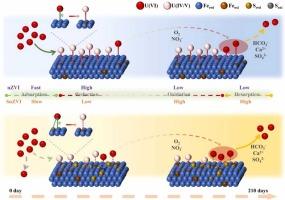硫修饰Fe0纳米颗粒固定化铀:U(VI)捕获动力学及长期稳定性评价
IF 11.3
1区 环境科学与生态学
Q1 ENGINEERING, ENVIRONMENTAL
引用次数: 0
摘要
通过在铁晶格中加载或掺入硫对纳米级零价铁(nZVI)进行改性,可以提高其去除废水中疏水污染物的效率。然而,硫包埋的nZVI (SnZVI)在固定亲水性铀酰离子中的反应性以及所固定的铀的长期稳定性却很少受到关注。本研究采用Na2S2O4对不同S/Fe摩尔比(0.1和0.3)的nZVI进行改性,采用一步法和两步法分别制备了SnZVI-1和SnZVI-2。实验和理论计算结果均表明,U(VI)离子对SnZVI表面具有较低的亲和力。此外,SnZVI与U(VI)电子给体之间的电子转移受到阻碍,导致SnZVI-1和SnZVI-2的U(VI)还原效率分别为50.71%~67.74%和68.03%~86.89%,低于nZVI的78.63%~90.78%。结果表明,在210天的稳定性评价中,SnZVI的铀剥离率(0.04%~0.85%)高于nZVI(0.04%~0.34%)。因此,本研究通过固体和水相样品分析,并结合理论计算,对硫如何影响nZVI对U(VI)固定化的吸附和氧化还原性能提供了新的见解。研究结果有助于设计SnZVI以有效和无害环境地处理铀污染的放射性废水。本文章由计算机程序翻译,如有差异,请以英文原文为准。


Uranium Immobilization via Sulfur-Modified Fe0 Nanoparticles: U(VI) Trapping Kinetics and Long-Term Stability Evaluation
The modification of nanoscale zero-valent iron (nZVI) by loading or incorporating sulfur into the iron crystal lattice can augment their efficacy in the removal of hydrophobic contaminants from wastewater. Nevertheless, the reactivity of sulfur-embedded nZVI (SnZVI) in immobilizing hydrophilic uranyl ions and the long-term stability of the sequestered uranium has received little attention. This study employed Na2S2O4 to modify the nZVI with different S/Fe molar ratios (0.1 and 0.3), following one-step and two-step approaches to create SnZVI-1 and SnZVI-2, respectively. Both experimental and theoretical calculation results revealed that the U(VI) ions exhibited low affinity for the surface of SnZVI. Additionally, the hindered electron transfer between the electron donors of SnZVI and U(VI) led to a diminished U(VI) reduction efficiency for SnZVI-1 (50.71%~67.74%) and SnZVI-2 (68.03%~86.89%), inferior to that of nZVI (78.63%~90.78%). Consequently, the uranium detachment ratios of SnZVI (0.04%~0.85%) during the 210-day stability assessment were higher compared to those of nZVI (0.04%~0.34%). Hence, this study offered novel insights into how sulfur affected the adsorptive and redox properties of nZVI for U(VI) immobilization through solid and aqueous samples analyses, complemented by theoretical calculations. The findings are instrumental in designing SnZVI for effective and environmentally sound treatment of uranium-contaminated radioactive wastewater.
求助全文
通过发布文献求助,成功后即可免费获取论文全文。
去求助
来源期刊

Journal of Hazardous Materials
工程技术-工程:环境
CiteScore
25.40
自引率
5.90%
发文量
3059
审稿时长
58 days
期刊介绍:
The Journal of Hazardous Materials serves as a global platform for promoting cutting-edge research in the field of Environmental Science and Engineering. Our publication features a wide range of articles, including full-length research papers, review articles, and perspectives, with the aim of enhancing our understanding of the dangers and risks associated with various materials concerning public health and the environment. It is important to note that the term "environmental contaminants" refers specifically to substances that pose hazardous effects through contamination, while excluding those that do not have such impacts on the environment or human health. Moreover, we emphasize the distinction between wastes and hazardous materials in order to provide further clarity on the scope of the journal. We have a keen interest in exploring specific compounds and microbial agents that have adverse effects on the environment.
 求助内容:
求助内容: 应助结果提醒方式:
应助结果提醒方式:


